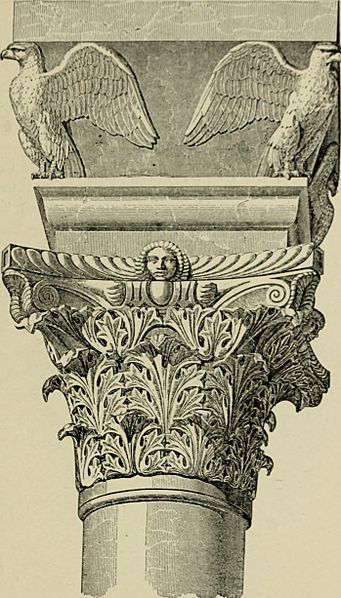Image: A history of architecture in Italy from the time of Constantine to the dawn of the renaissance (1901) (14597482728)

Description: Identifier: historyofarchit01cumm (find matches) Title: A history of architecture in Italy from the time of Constantine to the dawn of the renaissance Year: 1901 (1900s) Authors: Cummings, Charles Amos, 1833-1905 Subjects: Architecture Publisher: Boston, New York, Houghton Mifflin and company Contributing Library: PIMS - University of Toronto Digitizing Sponsor: University of Toronto View Book Page: Book Viewer About This Book: Catalog Entry View All Images: All Images From Book Click here to view book online to see this illustration in context in a browseable online version of this book. Text Appearing Before Image: hted candles, or twosheep, — birds or stagsdrinking at a fountain,which springs up below themonogram enclosed in awreath, or a lamb carryingthe cross and standtng ona mount of Paradise. — arethe most frequent subjects.Occasionally but very rarelythe beardless figure of OurSaviour appears, seated ona throne. Of historical sub-jects, properly so ealled,none are to be met with inthe whole series. (Lind-say, Christian Art, vol. i. p. 102.) Whereas in the early Christian work of Rome the sym-bolism is almost entirely absent, and the sculpture consists for the most part of figuresubjects. The centre of the face of the sarcophagus is generally occupied by a roundpanel containing the effigy of the person there entombed, — often of two persons, theman and his wife, or two brothers. — flanked by close set ranges of standing figures.Frequently there are two lines of subjects, representing scenes from the Old aud NewTestaments ; sometimes a rude arcade with standing figures in the arches. Text Appearing After Image: Fig. loo. Column of Mareian, Constantinople. 214 ARCHITECTURE IN ITALY sciil))tor, cut loose from the classic traditions, had created a new and))erfectly characteristic school of decorative sculpture. Perhaps theearliest example which remains to us is the capital of the colunniof Marcian, which stands now in the garden of a private housenear the centre of Constantinople, and which dates between 450 and45G. (Fig. 153.) It is a column of white marble about thirty-fivefeet high, including the pedestal. The capital in its outline andgeneral proportions follows the Corinthian j)retty closely, but with afreer treatment of the abacus and volutes and a vastly freer and moreartistic treatment of the leafage. The capital is surmounted by astilt-block of unusual size, with great eagles at the four angles withoutspread wings, which nearly meet in the centre of the face. Thestilt-block is, however, not in this instance to be regarded as the pro-totype of those which came a little later into freque Note About Images Please note that these images are extracted from scanned page images that may have been digitally enhanced for readability - coloration and appearance of these illustrations may not perfectly resemble the original work.
Title: A history of architecture in Italy from the time of Constantine to the dawn of the renaissance (1901) (14597482728)
Credit: https://www.flickr.com/photos/internetarchivebookimages/14597482728/ Source book page: https://archive.org/stream/historyofarchit01cumm/historyofarchit01cumm#page/n240/mode/1up
Author: Internet Archive Book Images
Permission: At the time of upload, the image license was automatically confirmed using the Flickr API. For more information see Flickr API detail.
Usage Terms: No known copyright restrictions
License: No restrictions
License Link: https://www.flickr.com/commons/usage/
Attribution Required?: No
Image usage
The following page links to this image:

